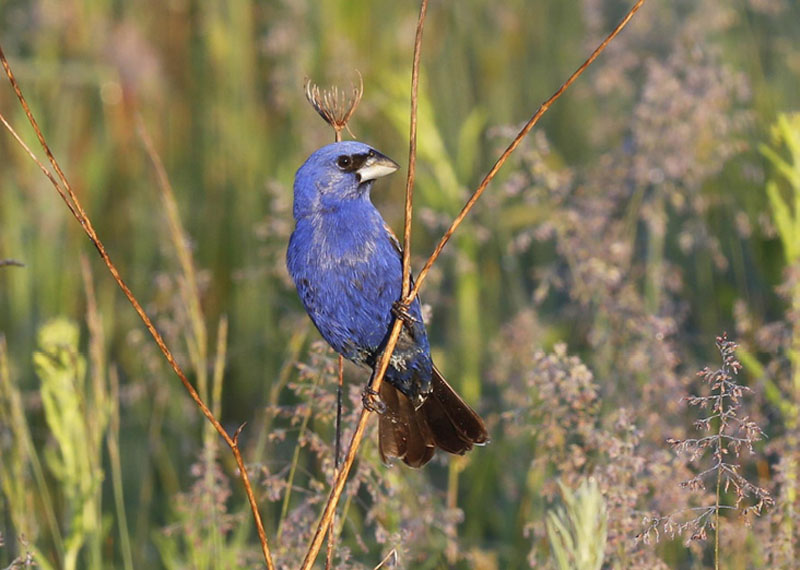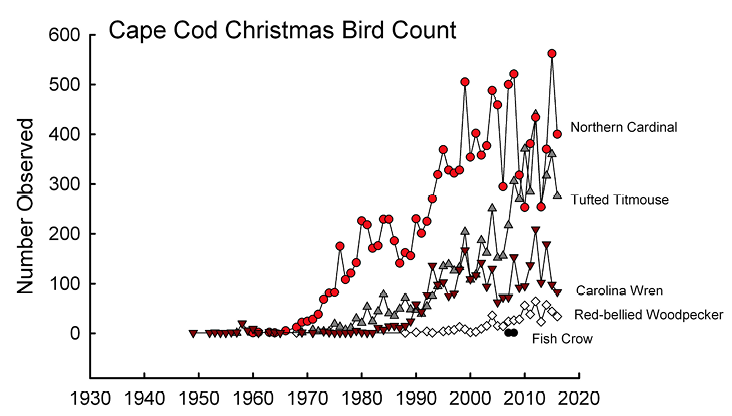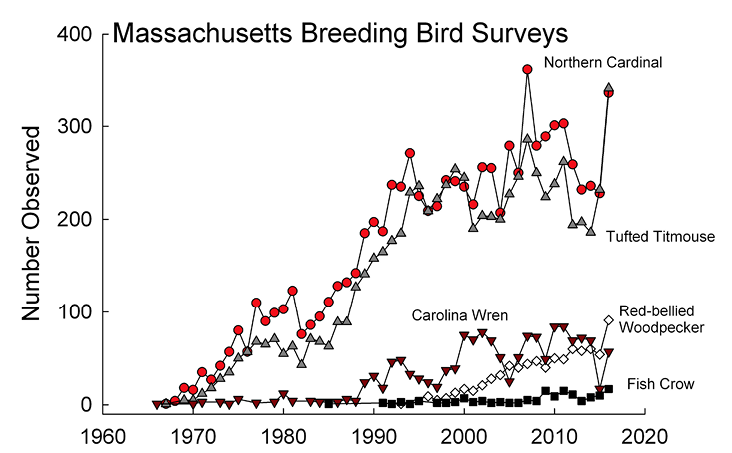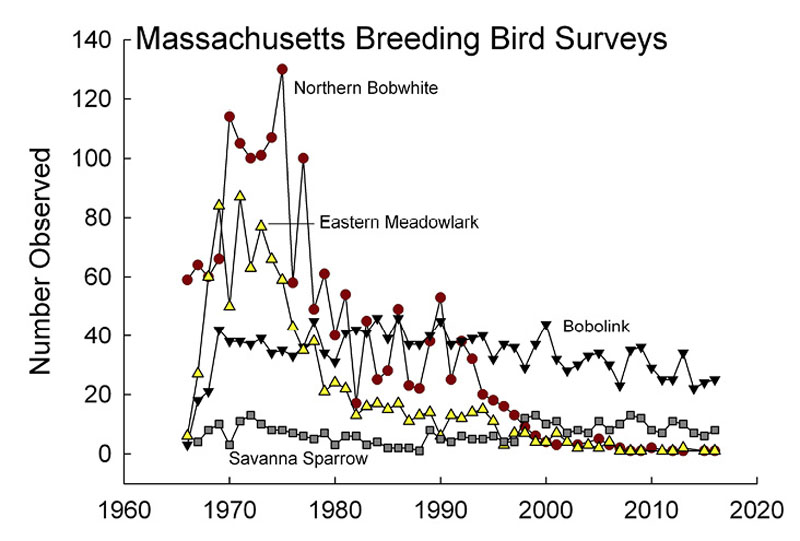Christopher Neill

Male Blue Grosbeak at the Crane Wildlife Management Area, June 3, 2017. Photograph by Craig Gibson.
On July 18, 2017 Nate Marchessault and I found and photographed the nest of a Blue Grosbeak (Passerina caerulea) with four large young at the Frances Crane Wildlife Management Area (WMA) in Falmouth, Massachusetts. Five days later, Nate and Alan Kneidel photographed a fledged bird in the shrub-filled kettle hole near the nest. These observations for the first time documented successful breeding of Blue Grosbeaks in Massachusetts (Marchessault 2017).
Successful breeding by Blue Grosbeaks in Massachusetts is not by itself surprising. A nesting attempt was documented in 2016 at the Cumberland Farms Important Bird Area in the towns of Middleborough and Halifax. Also, Blue Grosbeak is one of a growing list of bird species with southerly distributions that are expanding northward in the eastern U.S., including into Massachusetts. The accompanying photo shows a Blue Grosbeak at the Crane WMA in the summer of 2017.
What is important, however, was that the 2017 successful nesting occurred at a site that the Massachusetts Division of Fisheries and Wildlife (DFW) actively manages for sandplain grassland and shrubland habitat. The successful Blue Grosbeak nest was in the middle of a 48-acre area that DFW cleared in 2014 to expand grassland habitat. DFW cleared an additional 148 acres in 2015, and the Crane WMA now contains about 400 acres of unfragmented grassland habitat (Buelow 2017).

Figure 1A. Trends in numbers of Northern Cardinals, Tufted Titmice, Carolina Wrens, Red-bellied Woodpeckers, and Fish Crows recorded on the Cape Cod Christmas Bird Count since initiation of the count in 1930 (National Audubon Society 2017).
Massachusetts records going back to the middle of the last century show a number of bird species expanding north. We know from the Cape Cod Christmas Bird Count (CBC), which has run since 1930, that Northern Cardinals invaded in the 1970s, Tufted Titmice in the 1980s, Carolina Wrens in the 1990s, and Red-bellied Woodpeckers in the 2010s (Figure 1A). The first Fish Crows, which appeared on the count in 2007, are likely the vanguard of a future and more permanent presence. Massachusetts Breeding Bird Survey data show a similar timing of increase in these species (Figure 1B). The main difference is that Tufted Titmice expanded in the interior about a decade before they became common on Cape Cod.
Climate is almost certainly the principal driver of these changes. The center of abundance for 305 North American Bird species moved northward on average 40 miles between 1966 and 2014, largely because of warmer winter temperatures (La Sorte and Thompson 2007). Winter temperatures are increasing about 0.28°F per decade (Tibaldi et al. 2013), but the changes occur year-round. The northeast United States is warming faster than any United States region except Alaska (Karmalkar and Bradley 2017). Massachusetts’ average temperature has increased 1.2°F since 1960, and every year since 1993 has exceeded the 20th century average temperature (Bradley 2017).
This warming—including a projection that summer in Massachusetts by the end of this century could feel like the current summer in South Carolina—raises interesting and troubling questions about how birds will adapt. A recent Mass Audubon report rated 61of 143 breeding species “highly vulnerable” to climate change largely because places where they now live will become less suitable (Mass Audubon 2017). The mechanisms by which birds adapt to climate change by shifting ranges is a critical question.

Figure 1B. Trends in the numbers of those same species as recorded on all Massachusetts Breeding Bird Survey transects since 1967. Y-axis is the sum of the birds observed on all Massachusetts transects. Data from Pardieck et al. 2017.
Imagine you are a Northern Cardinal taking a chance on northward movement into new territory in Massachusetts. You have thousands of acres of woodland or yard edges to choose from. Same if you are a Tufted Titmouse, Carolina Wren, or Red-bellied Woodpecker. If you are a Fish Crow, you have miles of commercial strips and mall parking lots that roll out a red carpet.
But what if you are a Blue Grosbeak? You need a much more specialized grassland and shrubland habitat. However, that habitat is shrinking in the northeast—along with the many birds that depend on grasslands (Figure 2). So Blue Grosbeaks likely face a much different challenge than Cardinals or Titmice when adapting to climate change through northward expansion.
Think about how range expansions occur. Joseph Grinnell described this process in his 1922 paper in The Auk, “The Role of the Accidental.” Grinnell wrote, describing the expanding bird list for California at the time, “[T]here is indicated a continual appearance, within the confines of the state, through time, of additional species of extra-limital source.” He went on to state, “There is nothing really ‘accidental’ about it; the process is part of the ordinary evolutionary program.”
The vast majority of these pioneers are, in Grinnell’s words, “foredoomed to an early destruction without any opportunity of breeding.” But occasionally these accidentals find conditions to their liking, and a new population—or a range expansion—occurs.

Figure 2. Trends in numbers of selected grassland-associated species recorded on all Massachusetts Breeding Bird Survey transects since 1967. Y-axis is the sum of the birds observed on all Massachusetts transects. Data from Pardieck et al. 2017.
Take the case of the Cattle Egret. Cattle Egrets first appeared in Guyana and Suriname between 1877 and 1882 (Wetmore 1963) and first bred in the US in 1953 (Telfair 2006). Weather conditions that could allow these strong flyers to have crossed the Atlantic unaided almost certainly occur regularly (Massa et al. 2014). But the odds of successful expansion of the Cattle Egret’s range from the late 1800s to the present almost certainly increased with the presence of the combination of open land and large grazing animals in South, Central, and North America.
The presence of appropriate habitat is essential. In 25 years working along the southern edge of the Brazilian Amazon, I have watched Blue-black Grassquits (Volatinia jacarina) and Red-breasted Blackbirds (Sturnella militaris) expand into the pastures created from former rain forest.
When there is no corridor of appropriate habitat, scientists and managers now debate “assisted migration” as a way of avoiding the decline—or extinction—of species that have nowhere to move (McLachlan et al. 2007). In managing the Crane WMA as grassland and shrubland, the Massachusetts DFW created just the habitat Blue Grosbeaks needed to expand north.
More of this approach will be needed to help birds—and indeed a wide range of plants and animals—adapt to unprecedented rates of climate change. If projections of approximately 5°C warming in this century occur—which is looking more and more likely lacking dramatic reductions in fossil fuel use—then the Earth will have experienced about the same amount of global mean warming as it did at the end of the last ice age, but at a rate about 20 times faster. This rate of temperature change is unmatched by any comparable global temperature increase during the last 50 million years (Solomon et al. 2007).
Grinnell’s words nearly 100 years ago were prescient, “In a world of changing conditions it is necessary that close touch be maintained between a species and its geographical limits, else it be cut off directly from persistence[.]”
That close touch is more important today than ever before. Habitat management in advance of range shifts—particularly for species with more specialized habitat requirements—can be a key part of a regional conservation and climate change adaptation strategy. The Blue Grosbeaks we found show just how that approach can be successful.
Acknowledgments
I thank Nate Marchessault for letting me tag along in the discovery of the Blue Grosbeaks breeding at Crane. I thank Dov Sax for bringing the Grinnell article, “The role of the ‘accidental’,” to my attention. Thanks to Craig Gibson for permission to use his marvelous photo. CBC data are provided by National Audubon Society and through the generous efforts of Bird Studies Canada and countless volunteers. I also thank thousands of USA and Canadian participants who annually perform and coordinate the Breeding Bird survey.
References
- Bradley, R. 2017. Massachusetts. Climate System Research Center, State Climate Reports, University of Massachusetts, Amherst. https://www.geo.umass.edu/climate/stateClimateReports/MA_ClimateReport_CSRC.pdf
- Buelow, Chris. 2017. Personal communication; interview with Lina Champlin.
- Grinnell, J. 1922. The role of the “accidental.” The Auk 39: 373–380.
- Karmalkar, A. V. and R. S. Bradley. 2017. Consequences of Global Warming of 1.5 °C and 2 °C for Regional Temperature and Precipitation Changes in the Contiguous United States. PLOS One https://doi.org/10.1371/journal.pone.0168697
- La Sorte, F. A., and F. R. Thompson III. 2007. Poleward shifts in winter ranges of North American birds. Ecology 88: 1803–1812.
- Walsh, J. M., and M. S. V. Servison, eds. 2017. State of the Birds 2017: Massachusetts Birds and Our Changing Climate. Massachusetts Audubon Society. Lincoln, Massachusetts http://www.massaudubon.org/content/download/21633/304821/file/mass-audubon_state-of-the-birds-2017-report.pdf.
- Marchessault, N. 2017. Field Note: Blue Grosbeak Nesting Successfully in Massachusetts. Bird Observer 45(5): 326–329.
- Massa, C., M. Doyle and R. C. Fortunato. 2014. On how Cattle Egret (Bubulcus ibis) spread to the Americas: meteorological tools to assess probable colonization trajectories. International Journal of Biometeorology 58: 1879–1891.
- McLachlan, J. S., J. J. Hellmann, and M. W. Schwartz. 2007. A Framework for debate of assisted migration in an era of climate change. Conservation Biology 21: 297–302.
- National Audubon Society. 2017. The Christmas Bird Count Historical Results [Online]. Available at: http://www.audubon.org/conservation/science/christmas-bird-count/Accessed September 2017.
- Niven, D. K. and G. S. Butcher. 2009. Northward shifts in the abundance of North American birds in early winter: A response to warmer winter temperatures? National Audubon Society. http://web4.audubon.org/bird/bacc/techreport.html.
- Pardieck, K. L., D. J. Ziolkowski Jr., M. Lutmerding, K. Campbell and M.-A.R. Hudson. 2017. North American Breeding Bird Survey Dataset 1966–2016, version 2016.0. U.S. Geological Survey, Patuxent Wildlife Research Center. Laurel, Maryland. http://www.pwrc.usgs.gov/BBS/RawData/; doi:10.5066/F7W0944J.
- Solomon, S., D. Qin, M. Manning, Z. Chen, M. Marquis, K. B. Averyt, M. Tignor and H. L. Miller (Eds.). 2007. Contribution of Working Group I to the Fourth Assessment Report of the Intergovernmental Panel on Climate Change, 2007. Cambridge University Press, Cambridge, U.K.
- Telfair II, R. C. 2006. Cattle Egret (Bubulcus ibis), version 2.0. In The Birds of North America Online (P. G. Rodewald, ed.). Ithaca: Cornell Lab of Ornithology: https://doi.org/10.2173/bna.113
- Tibaldi, C., D. Adams-Smith and A. Kenward. 2013. Warming Winters: U.S. Temperature Trends. Climate Central, Princeton, New Jersey. www.climatecentral.org/wgts/warming-winters/WarmingWinters.pdf
- Wetmore, A. 1963. An early record of the Cattle Egret in Colombia. The Auk 80: 547.
Christopher Neill is an ecologist and Senior Scientist at the Woods Hole Research Center in Falmouth, Massachusetts. He studies the consequences of deforestation and expanding agriculture in the Brazilian Amazon, and approaches to management and restoration of grasslands, shrublands, and wetlands in coastal Massachusetts. He has participated in the Cape Cod Christmas Bird Count since 1989.